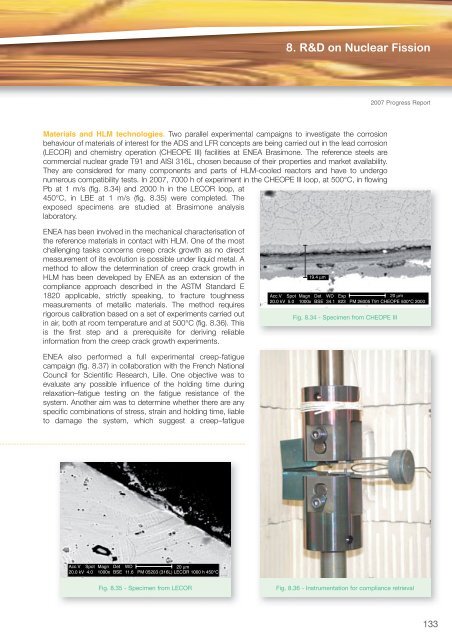Fusion Programme - ENEA - Fusione
Fusion Programme - ENEA - Fusione
Fusion Programme - ENEA - Fusione
- No tags were found...
Create successful ePaper yourself
Turn your PDF publications into a flip-book with our unique Google optimized e-Paper software.
8. R&D on Nuclear Fission2007 Progress ReportMaterials and HLM technologies. Two parallel experimental campaigns to investigate the corrosionbehaviour of materials of interest for the ADS and LFR concepts are being carried out in the lead corrosion(LECOR) and chemistry operation (CHEOPE III) facilities at <strong>ENEA</strong> Brasimone. The reference steels arecommercial nuclear grade T91 and AISI 316L, chosen because of their properties and market availability.They are considered for many components and parts of HLM-cooled reactors and have to undergonumerous compatibility tests. In 2007, 7000 h of experiment in the CHEOPE III loop, at 500°C, in flowingPb at 1 m/s (fig. 8.34) and 2000 h in the LECOR loop, at450°C, in LBE at 1 m/s (fig. 8.35) were completed. Theexposed specimens are studied at Brasimone analysislaboratory.<strong>ENEA</strong> has been involved in the mechanical characterisation ofthe reference materials in contact with HLM. One of the mostchallenging tasks concerns creep crack growth as no directmeasurement of its evolution is possible under liquid metal. Amethod to allow the determination of creep crack growth inHLM has been developed by <strong>ENEA</strong> as an extension of thecompliance approach described in the ASTM Standard E1820 applicable, strictly speaking, to fracture toughnessmeasurements of metallic materials. The method requiresrigorous calibration based on a set of experiments carried outin air, both at room temperature and at 500°C (fig. 8.36). Thisis the first step and a prerequisite for deriving reliableinformation from the creep crack growth experiments.19.4 μmAcc.V Spot Magn Det WD Exp20 μm20.0 kV 5.0 1000x BSE 34.1 823 PM 26005 T91 CHEOPE 500*C 2000Fig. 8.34 - Specimen from CHEOPE III<strong>ENEA</strong> also performed a full experimental creep-fatiguecampaign (fig. 8.37) in collaboration with the French NationalCouncil for Scientific Research, Lille. One objective was toevaluate any possible influence of the holding time duringrelaxation–fatigue testing on the fatigue resistance of thesystem. Another aim was to determine whether there are anyspecific combinations of stress, strain and holding time, liableto damage the system, which suggest a creep–fatigueAcc.V Spot Magn Det WD20 μm20.0 kV 4.0 1000x BSE 11.6 PM 05203 (316L) LECOR 1000 h 450°CFig. 8.35 - Specimen from LECORFig. 8.36 - Instrumentation for compliance retrieval133













